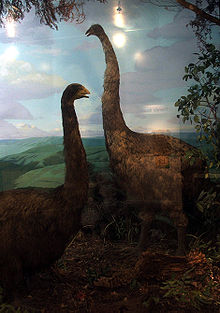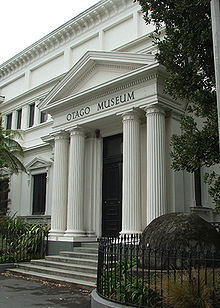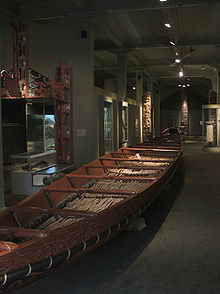- Otago Museum
-
 Reconstructed moa. The museum holds the world's largest collection of moa remains.
Reconstructed moa. The museum holds the world's largest collection of moa remains.
The Otago Museum is situated in Dunedin, New Zealand. It was founded in 1868 and has a collection of over two million artefacts and specimens from the fields of natural history and ethnography. It is adjacent to the University of Otago campus in Dunedin North, 1,500 metres northeast of the city centre.
The museum has changed over the years, a 2002 development being the addition of a new display area "Southern land, Southern people", dealing with the prehistory and history of the Otago region, and the refurbishment of galleries devoted to the cultures of Melanesia. The museum has an outstanding Pacific Island collection, Australasia's most significant Classical collection, and the premier ceramic collection in New Zealand. It also houses a large assembly of natural history items. Notable among the latter is material related to New Zealand bird-life, including the world's most extensive collection of Moa remains.
The initial collection consisted of material from the 1865 New Zealand Exhibition (held in Dunedin). The King Street portion of the present building was completed in 1877, and was designed by David Ross (1828-1908). Further wings (the Hocken and Fels) and the centennial, were added in 1910, 1923 and 1963. The museum also houses lecture theatres and an interactive children's display centre ("Discovery World"), as well as a research centre and galleries which regularly host touring exhibitions. The entrance foyer is also home to a shop and cafeteria.
On 3 November 2007 the newest addition to the Otago Museum opened to the public, the three storeyed "Tropical Forest". This features a variety of flora and fauna from around the globe, including many species of butterfly from Asia and the Caribbean.
The museum had a record 472,600 visits in the year ending 30 June 2008.[1]
References
- ^ "Otago Museum visitors up 77%". Otago Daily Times. 17 December 2008. http://www.odt.co.nz/your-town/dunedin/36475/otago-museum-visitors-77. Retrieved 2008-12-17.
External links
- Museum website
 Media related to Otago Museum at Wikimedia Commons
Media related to Otago Museum at Wikimedia Commons
Coordinates: 45°51′56.44″S 170°30′39.03″E / 45.8656778°S 170.5108417°E
Categories:- Buildings and structures in Dunedin
- Museums established in 1868
- Natural history museums in New Zealand
- Visitor attractions in Dunedin
- Dunedin culture
- Oceanian museum stubs
- New Zealand building and structure stubs
Wikimedia Foundation. 2010.



